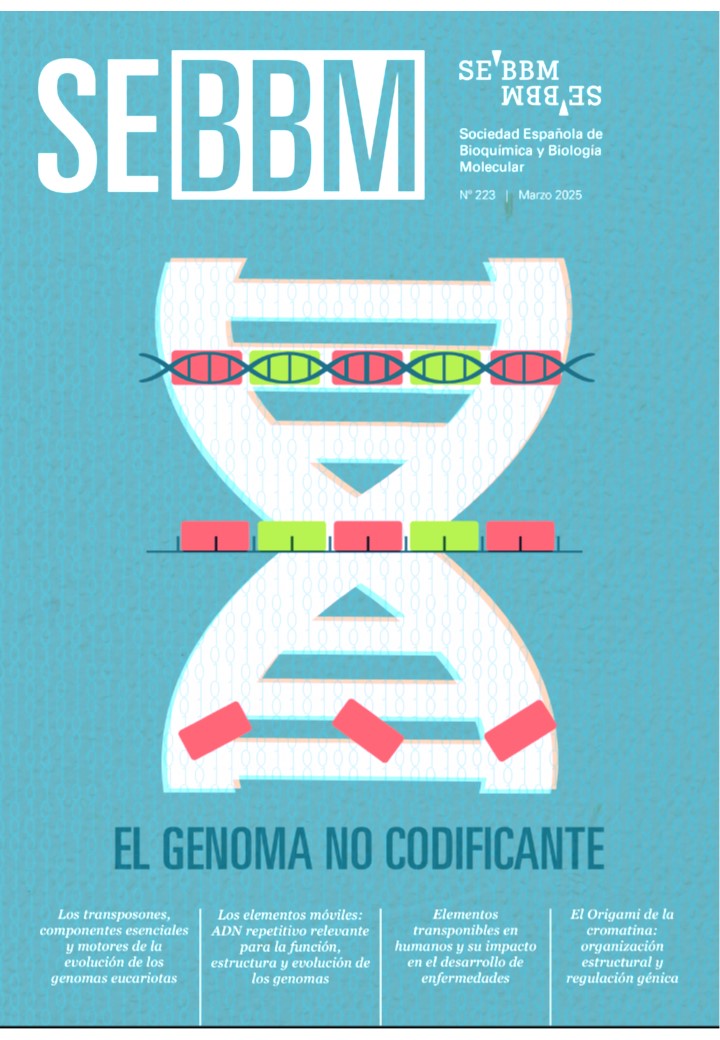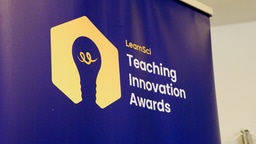SEBBM Journal, issue nº 223: “The non-coding genome”

The SEBBM Journal is a channel for analysis, reflection and dissemination of scientific activity in Spain and of public and private research policies. Its origins date back to 1963, and it currently publishes thematic issues covering transversal research in the field of biochemistry and molecular biology. The articles are commissioned by the best specialists in the subject. Each issue also highlights the most relevant educational and scientific work of SEBBM members, as well as SEBBM news.
The current issue “The non-coding genome” (nº 223, March 2025) has been coordinated by Prof. Dr. Crisanto Gutiérrez, Head of Genome Dynamics and Function Programme from Centro de Biología Molecular ‘Severo Ochoa’ (CBM), CSIC/UAM, and is available at https://sebbm.es/revista/numeros/el-genoma-no-codificante/
“All the information necessary for the life of organisms is stored in their genome. When talking about their importance, we tend to think only of the protein-coding regions of the genome as the most functionally and organizationally relevant. However, sequencing data from hundreds of genomes have revealed that the fraction of the genome occupied by coding sequences is actually a minority. Notably, after the enormous amount of the genome occupied by non-coding repeat sequences was demonstrated, these regions came to be considered “junk DNA.” Although ~75% of the regions of the human genome are transcribed, only 2% are translated into proteins, while the rest correspond to non-coding RNAs (ncRNAs). In fact, the presence of large amounts of non-coding DNA, which may or may not be transcribed, is a feature of the genomes of all species studied, including fungi, plants, and animals.
Deciphering the structural and functional relevance of these regions has not been, and is not being, an easy task not only because of the number but also because of the diversity of genomic elements included in this category.
The non-coding genome is composed of various elements that globally belong to two major groups: the repeat sequences and the regulatory sequences. The genomic regions containing repeat sequences include not only the telomeric and centromeric regions but also the transposons or mobile elements of the genome, whose existence was proposed by Barbara McClintock in the 1940s and 1950s and whose exceptional and pioneering research was awarded the Nobel Prize in 1983. The rest of the non-coding genome with regulatory functions is made up of introns and intergenic regions that are transcribed to produce RNAs in enhancers (eRNAs), long non-coding RNAs (long ncRNAs), microRNAs (miRNAs) or circular RNAs (cirRNAs).
Issue nº 223 of SEBBM Journal includes four articles on the organisation, function, and relevance of transposons and enhancers, which give us insight into these genomic elements.
Dr. Josep Casacuberta and Dr. Elena Casacuberta describe transposons, their structural organisation , and their relevance in stress response and mutation production in both plants and animals. Transposons modify the development of organisms, particularly plants, to adapt their growth to changing environmental conditions. https://doi.org/10.18567/sebbmrev_223.202503.dc2
Dr. Josefa González addresses two very relevant aspects of transposon biology, derived from their ability to move from one region of the genome to another. On the one hand, they function as regulators of gene expression by inserting themselves in areas close to the start of transcription of some genes and possessing promoters and transcription factor binding sequences. On the other hand, the mobility of transposons contributes to the generation of new transcripts that can modify the adaptability and evolution of species. https://doi.org/10.18567/sebbmrev_223.202503.dc3
Dr. Bernardo Rodríguez-Martín and Dr. Layla Díaz-Portal, a student in his laboratory, shed light on the consequences of mobile element transposition in human health. The article illustrates the consequences of transposon insertions in the germline and their implication in diseases such as cancer. https://doi.org/10.18567/sebbmrev_223.202503.dc4
Finally, Dr. Leonardo Beccari, together with his student Jorge Mañes García, focuses their contribution on other non-coding genome elements fundamental in the regulation of gene expression, the enhancers, and how their function depends on the structural organisation of the genome within the eukaryotic nucleus in topologically associated domains (TADs). https://doi.org/10.18567/sebbmrev_223.202503.dc5 “
You can also visit the interview, education, and scientific research sections ... among others. https://sebbm.es/revista/numeros/el-genoma-no-codificante/
Part of this post is a translation of an article written in Spanish by Profesionales. Dr. Crisanto Gutiérrez, from Centro de Biología Molecular ‘Severo Ochoa’ (CBM), CSIC/UAM, and published on the SEBBM website on March, 2025.
Reference: Gutiérrez C. 2025. El genoma no codificante. SEBBM 223 https://doi.org/10.18567/sebbmrev_223.202503.dc1





Join the FEBS Network today
Joining the FEBS Network’s molecular life sciences community enables you to access special content on the site, present your profile, 'follow' contributors, 'comment' on and 'like' content, post your own content, and set up a tailored email digest for updates.